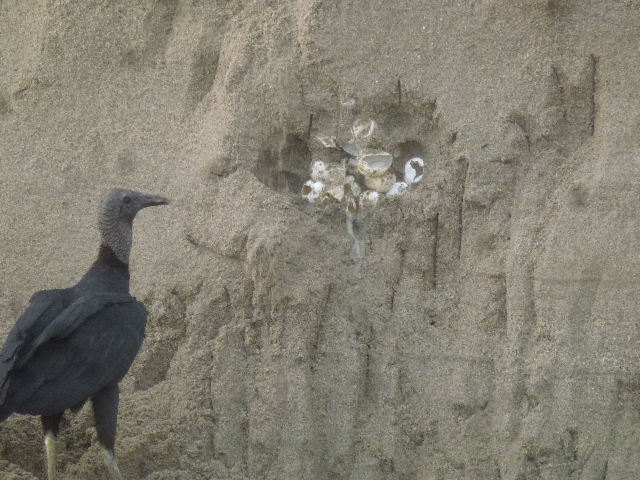CGO Ecology has been busy lately. A recent highlight was visiting the Caribbean islands of Trinidad & Tobago, where we were honoured to be guests of sea turtle conservation charity SOS Tobago - Save Our Sea Turtles Tobago. Program Manager Giancarlo Lalsingh took us to see their excellent monitoring and guardian work first-hand, all achieved on limited means. We saw five giant nesting female leatherbacks that night - a moving experience, and an impressive spectacle.
There are several important leatherback nesting beaches on the Caribbean 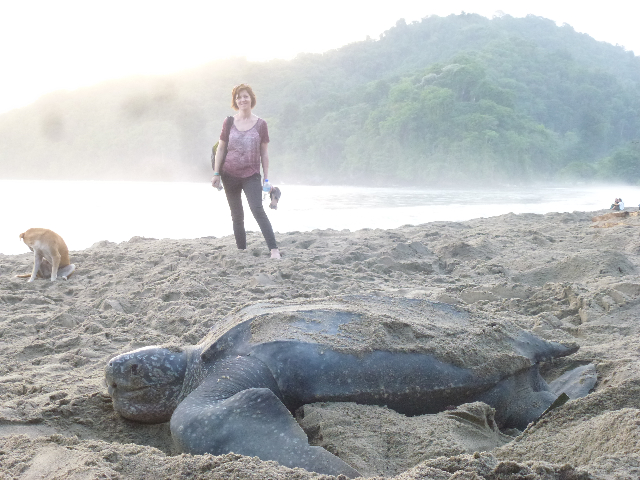
SOS Tobago works tirelessly to protect nesting sea turtles, whilst trying to reconcile the various human demands on beaches. It is a small organisation, run by a few key people on a limited budget, assisted by seasonal volunteers. CGO Ecology Ltd was able to make a donation of 1500 USD towards SOS Tobago's work, and it was also our privilege to make some personal donations towards their excellent turtle adoption programme. See their website for details. Adoptions make great gifts for children or adults!
After a week in Tobago, we moved on to Trinidad (in spite of the protestations of a few Tobagonians and British ex-pats that it wasn't safe!). Trinidad is of course just as friendly and welcoming as Tobago. At Grande Riviere on the north coast of Trinidad we spent four days being spoilt by the wildlife spectacles on offer.
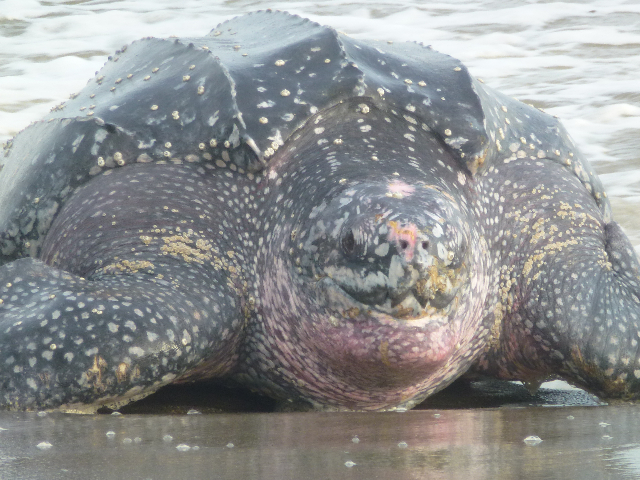
A guided 'tour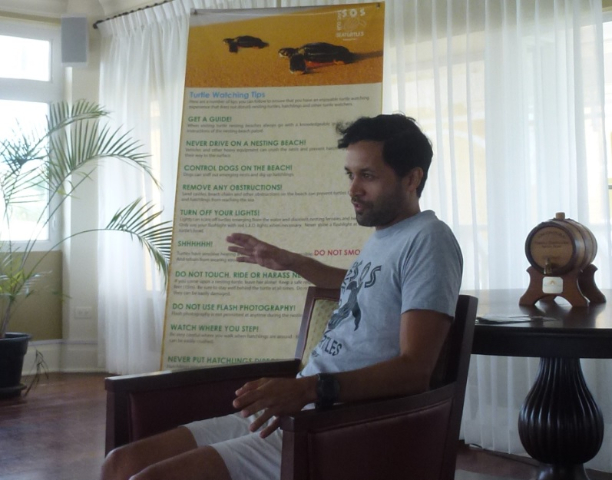 ' is the ideal way of seeing nesting turtles close-up. No torches/flashlights are allowed, except for the red-filtered head-torch of the guide. The whole nesting process takes two hours for each turtle, in the following sequence: emergence, 'body-pitting' (clearing the area), digging of the egg chamber, egg-laying, backfilling and camouflaging. A 10m distance is observed during all but the egg-laying phase; during this 15-minute interval, turtles enter an 'egg-laying trance' and seem oblivious to people around them. The guides allow visitors to watch eggs falling into the bucket-sized pit at close range under red light, and even invite you to place your hand on the soft neck of the turtle.
' is the ideal way of seeing nesting turtles close-up. No torches/flashlights are allowed, except for the red-filtered head-torch of the guide. The whole nesting process takes two hours for each turtle, in the following sequence: emergence, 'body-pitting' (clearing the area), digging of the egg chamber, egg-laying, backfilling and camouflaging. A 10m distance is observed during all but the egg-laying phase; during this 15-minute interval, turtles enter an 'egg-laying trance' and seem oblivious to people around them. The guides allow visitors to watch eggs falling into the bucket-sized pit at close range under red light, and even invite you to place your hand on the soft neck of the turtle.
May is the peak month for leatherbacks nesting in Trinidad & Tobago, and at Grande Riviere up to 300 can nest on any one night. The beach is barely 1.5km long, and this arguably makes it the highest-density nesting beach for leatherbacks in the world.
The other benefit of having so many turtles on one beach is that an early morning trip to the beach can yield daytime encounters with the last few leatherbacks nesting before the sun comes up too far. On our first morning at Grand Riviere we saw four; on another morning we saw six. It is still important to observe a 10m distance from nesting turtles generally, but the photographic opportunities are amazing. Seeing turtles in daylight also gives you a much better understanding of their physical appearance. It is amazing just how prehensile their rear flippers are when excavating the egg chamber; each flipper dexterously clasps a flipperful of sand, and throws it to one side.
We were also lucky enough to experience the emergence of a few 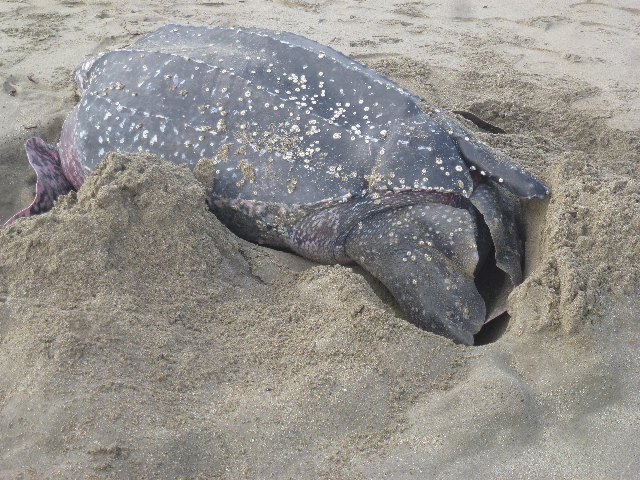
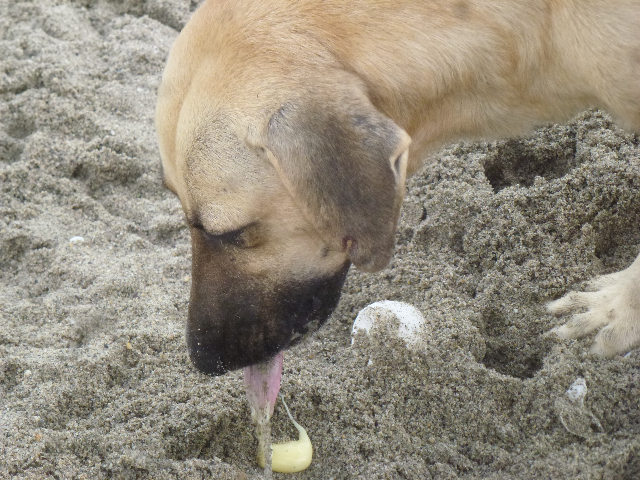
For five anxious minutes we watched our hatchling scoot along the swash zone, frustratingly never quite making it into the sea (it was following the sun rather than the sea). Eventually it got caught in the tide (to cheers from the gathering crowd), only to be washed up again moments later on its back! We intervened once again and tipped it back the right way, and moments later it was back in the surf. Luckily no frigatebirds spotted it, and so this was one leatherback hatchling saved.
The peak emergence season for leatherback hatchlings in Trinidad & Tobago is July, two months after the peak nesting season (incubation takes two months). Leatherbacks start nesting in March; hawksbills mest from late May onwards; and both are found on both islands. Trinidad also has a few green turtles nesting on its beaches. We saw one emerge at night but th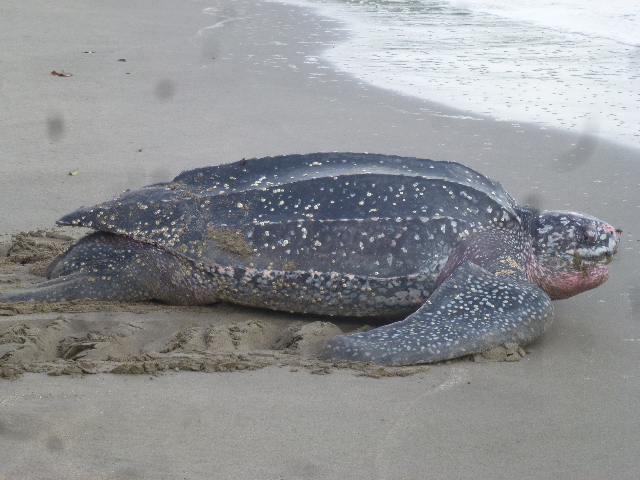
We saw a few other dead hatclings over the next few days, but no more live emergences. Beach dogs tend to dig up and eat any hatchlings they find, and may kill and cache them for later. Black vultures seem unable to eat hat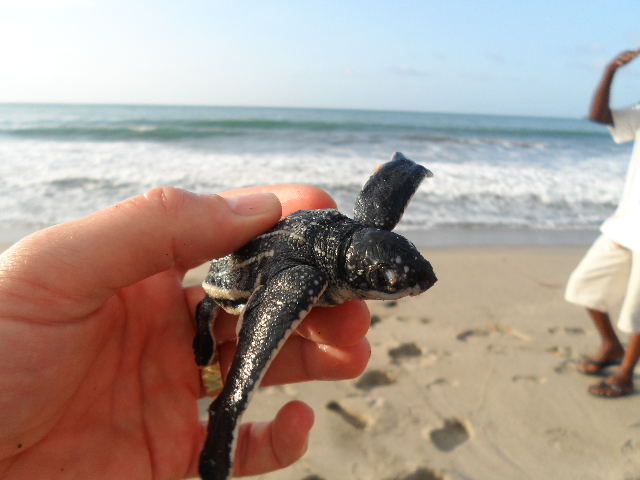
A holiday in Trinidad & Tobago is highly recommended, with great opportunities for responsible tourism. We would recommend supporting the work of SOS Tobago if visiting Tobago, but it is also well worth the effort to visit neighbouring Trinidad.
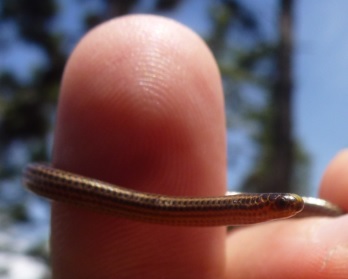 Another herpetological highlight was seeing a tiny worm snake crossing a forest path at Mount St Benedict, near Tunapuna in Trinidad. As yet unidentified (Typhlops or Leptotyphlops), this is a rare sighting of a tiny snake resembling a thin brown shoelace about 15cm long. There are three species in Trinidad, and knowledge of the distribution of all of them is very scant.
Another herpetological highlight was seeing a tiny worm snake crossing a forest path at Mount St Benedict, near Tunapuna in Trinidad. As yet unidentified (Typhlops or Leptotyphlops), this is a rare sighting of a tiny snake resembling a thin brown shoelace about 15cm long. There are three species in Trinidad, and knowledge of the distribution of all of them is very scant.
The herp sightings list also included cane toads, whistling frogs, green iguana, various as-yet-unidentified lizards, and a dead boa constrictor. Among the birds, a tiny owl at Grande Riviere was one of the highlights.
All in all, Trinidad & Tobago is an excellent destination for the wildlife enthusiast. CGO Ecology hopes to develop some collaborative projects with SOS Tobago in the future, and to assist with fundraising and awareness-raising. Let's hope it's not too long before another trip to 'T&T' is on the cards, and perhaps next time we'll also manage to visit the elusive manatee in Nariva Swamp.
Of course, there is a terrible footnote to this account of Caribbean sea turtle conservation activities. Just a few days ago in Costa Rica, turtle guardian and conservationist Jairo Mora Sandoval was murdered for doing the work he loved. It is a sad reflection of the lengths that narco gangs and turtle egg poachers will go to preserve their lucrative interests.
Finally, thanks to all the surveyors and subcontractors who have worked for CGO Ecology this year; our donation to SOS Tobago wouldn't have been possible without you.


